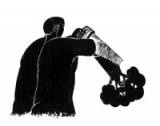Thursday, April 25, 2024
News and Views from the Global South

The Amazon Possible
- The Amazon is a privileged space where we can also achieve the invention of a sustainable policy, writes Marina Silva, former environment minister of Brazil, in this exclusive column for Tierramérica.
As if the Amazon were the last limit of our dead-end streets, where the forest or the water could be devoured without leaving traces of our irresponsibility, ignorance, lack of vision or right-now attitudes.
Meanwhile, another front is advancing, moved by awareness, understanding and experience, to change directions and demonstrate that the Amazon can only be treated and understood correctly if Brazil is too.
With that political viewpoint we now have an opportunity to escape from the dead zone, just as we face the crossroads of two major crises: the environment and the economy.
At this point, the Amazon constitutes a strategic reserve of potential for a new kind of development for this country. The opportunities depend on a structural change in focus, already made by some sectors of society, the government and businesses, but at a scale that is still insufficient for making it into a principal foundation.
It is intolerable that illegal deforestation continue in the Amazon or in any Brazilian ecosystem. The environmental wealth it takes from us is a part of the opportunity to develop Brazil according to parameters of economic, social, cultural and environmental sustainability.
In the case of the Amazon jungle, the repercussions of its persistent destruction range from the global — we are the fourth leading emitter of carbon, due mostly to deforestation — to the national and continental.
As shown by the studies of the National Institute of Amazon Research, evaporation taking place across the five million square kilometers of Amazon jungle is vital for supplying humidity to part of the central-west, southeast and south of the country and of South America.
Therefore, preventing deforestation is to prevent serious climate imbalances in areas of high concentration of population and agricultural production, like São Paul, Mato Grosso and Paraná.
It is a false argument that more forest needs to be cut down in order to expand the farming frontier. There are some 165,000 square kilometers of deforested areas that are underutilized or abandoned.
It is also false that exploration of those areas is not economically viable. There is technology, developed largely by EMBRAPA, the Brazilian agricultural research agency. As for costs, they need to be compared to what the country has to pay for the destruction of new portions of jungle and the loss of its environmental services.
This reminds of the notable documentary “O Vale” (The Valley), from 2000, directed by filmmaker João Moreira Salles and journalist Marcos Sá Corrêa.
The film shows the social, economic, cultural and environmental tragedy caused by the large-scale adoption of an unsustainable agricultural production model, which had as its basis the destruction of the Mata Atlantica forest in the Paraíba River valley in Brazil's southeast.
The same model that produced indescribable wealth for a few coffee barons, marking the zone with a fictitious sensation of development, did not last more than 50 years. The damages are still there for all to see: heirs of the upper classes now living in poverty, the lower classes now in misery, desiccated and degraded land.
These tragedies should serve as lessons and should infuse with meaning, purpose and reason the logic of the still dominant development model.
The government should ensure that the levels of socio-environmental governance achieved in the Amazon are maintained. Land-use zoning should continue to advance. Between 2003 and 2007 we reduced vacant fiscal lands in the Amazon from 40 percent to 28 percent by creating conservation units and indigenous territories.
With that designation of lands we increased protected areas from 29 to 41 percent of the Amazon. It is essential to continue reducing that frontier of vacant lands and, at the same time, continue increasing protected areas, structuring them so that they serve environmental, social and economic functions.
The ministries that deal with economics should make incentive policies a priority and the government should assign a budget in keeping with the magnitude of this challenge. The first Plan for the Prevention and Control of Deforestation of the Amazon had about 200 million dollars from 2004 to 2007 to apply structural measures, especially in satellite monitoring, auditing and creation of conservation areas.
Those measures contributed significantly to reducing the pace of deforestation by 57 percent between 2005 and 2007.
The demand for resources for the next period of the Plan to Fight Deforestation is not yet clear. In 2007, a group of non-governmental organizations active in the region estimated that an annual investment of one billion reais (about 460 million dollars) would be needed to reduce deforestation to zero in seven years.
With the creation of the Amazonia Fund, Brazil has an intelligent and highly credible mechanism for gathering international contributions that help in this effort. But those resources must be joined with robust national investments.
Preserving the Amazon and promoting improvements in the lives of its population is a civilization challenge for Brazil and the world. Our success will depend on the perseverance of the public agents in continuing to expand environmental governance and on the political support that society provides to ensure that the process is not interrupted.
It is important to understand the Amazon as a privileged space where we can also achieve the creation of a sustainable policy.

 Print
Print




